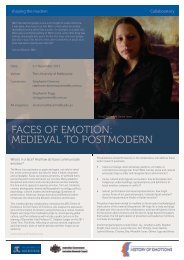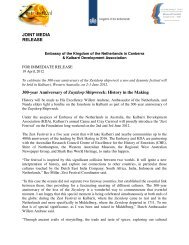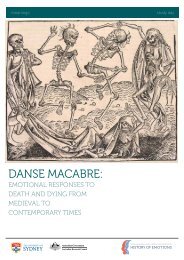Leechdoms, wortcunning, and starcraft of early England. Being a ...
Leechdoms, wortcunning, and starcraft of early England. Being a ...
Leechdoms, wortcunning, and starcraft of early England. Being a ...
Create successful ePaper yourself
Turn your PDF publications into a flip-book with our unique Google optimized e-Paper software.
—<br />
—<br />
;<br />
384 GLOSSARY.<br />
Felrpypr cont.<br />
was Latinised (Gl. Somn. p. 59 a, 58)<br />
as feltrum, filtrum (John de Garlond,<br />
p. 124); Dansk, filt, felt; Swedish, filt,<br />
mase. feU; Germ., filz, masc. felt. The<br />
drawing in MS. V. fol. 37 d, represents<br />
the plant. " Filtrum terre, anglice lelt-<br />
" wort vel molayn idem." Gl. Rawl.<br />
c. 607. " Thapsus barbastus [read bar-<br />
" hatus], G. moleyn, A. felwort." Gl.<br />
Sloane, 5 ; so Gl. Sloane, 405. In Gl.<br />
Somn. 63 b, 38, read Anadonia, yelrpypt.<br />
Teltwort yel hegetaper, Gl.<br />
Arund. 42.<br />
Fepbjiypt, fem., gen. in -e. Lb. I.<br />
Ixxxvii.<br />
Fep>e, masc, sound part Lb. L i. 15.<br />
" Probus ferth," Gl. M.M. p. 160 b, 20.<br />
Leasyep'Snes, false probity, P.A. 59 b.<br />
Sec yepe, Chron. 1016, <strong>and</strong> Layamon,<br />
1052, 1075, 1055. But there is also a<br />
syllable yep'Sin " j-eoluj-eja-S, torax." Gl.<br />
C, that is, Oupa^, from perhaps Lorica,<br />
p. Ixxii. Cf Gl. Cleop. fol. 85 b, <strong>and</strong><br />
yelufejiiS, ceniumpellio, Gl. Cleop. fol.<br />
26 b, which appears to be an altered<br />
form <strong>of</strong> centipedem. In these two words<br />
it is possible that yeji-Se may signify<br />
ring, which would suit Lb. well. So,<br />
Fleoreubpa yep'S, C.E. 289, line 26, a<br />
ring <strong>of</strong>floating ones. = ferci firci,^/,^^.^<br />
Fic, Geps, masc, a disease known as ficus,<br />
IvKri, '2,vKov, 'S.vKoiixa, 'S.vkuktis. In the<br />
Lb. I. ii.<br />
22, the disease " fig " is said to<br />
be x^h'-^'^'-^^<br />
^ moisture in the skin enclosing<br />
the eyes (Florio), but without<br />
exactly negativing that statement we<br />
must bend to an overwhelming weight<br />
<strong>of</strong> testimony, <strong>and</strong> accept it as an excrescence<br />
like a fig with an ulcer, so called<br />
from a fig bursting with fatness, " ficus<br />
" hians prte pinguedine." It affects all<br />
parts <strong>of</strong> the body which have hair, especially<br />
the eyebrows, beard, head, <strong>and</strong><br />
anus ; <strong>and</strong> it was sometimes called<br />
marisca. Dioskor. i. 100 ; Pollux from<br />
Apsyrtus, iv. 203 ; Celsus, vi. 3 ; Paulus<br />
^gineta, iii. 3 ; Psellus in Ideleri Phys.,<br />
Fic<br />
cont.<br />
vol. i. p. 223, 704 ; Pollux, iv. 200<br />
Aetius; Martialls; Hippokrates, p. 1085<br />
H. ; Oribasius ap. Phot, p. 176, 3 ;<br />
Schol. Aristoph. Pan., 1247. These<br />
references I have taken from the Paris<br />
ed. <strong>of</strong> Etienne. The name was in constant<br />
technical use among mediaeval<br />
medical writers.<br />
'• Contra ficum arden-<br />
" tem," "Contra ficum sanguinolen-<br />
" tum," " Contra ficum corrodentem,"<br />
" Contra ficum nomere facientem." MS.<br />
Sloane, 146, fol. 28. Haemorrhoids are<br />
ficblattern in the [H]ortus Sanitatis. In<br />
Florios time (1611) fico in Italian had<br />
been reduced to " a disease in a horses<br />
"foot." Cotgrave (1673) has "fie, a<br />
" certain scab, or hard, round, <strong>and</strong> red<br />
" sore, in the fundament." " Fijck,<br />
" tuberculum acutum cum dolore et<br />
" inflammatione," (Kilian). It was a<br />
running sore, Lb. I. xxxix. ; it was<br />
equivalent to J^eopabl, Lb. I. ii. 22.<br />
Written Uic, <strong>and</strong> masc, Lacn. 6 ; 44,<br />
following the Latin usage.<br />
" Dicemus ficus quas scimus in arbore<br />
" nasci,<br />
" Dicemus ficos, Cseciliane, tuos."<br />
Martialis, I. 66.<br />
Hie fygus, the fyge. Wrights Gl. p. 224.<br />
Filb, Lb. I. Ixvii., with Filbcimib, Lb. III.<br />
liii., may be taken to mean the milk<br />
drawn at one milking from how many cows<br />
soever; commonly called the mornings<br />
milk, the evenings milk.<br />
In a dairy every<br />
several milking is kept separate. ^<br />
FiUe, an apocopate form <strong>of</strong> cepplle, chervil,<br />
anthriscus cerefolium, as cl<strong>early</strong> appears<br />
from a comparison <strong>of</strong> the poetical names,<br />
Lacn. 46, with the same in prose. " Cer-<br />
" folium . i . cerfoil . i . villen," Gl. Harl.<br />
978 (A.D. 1240).<br />
FleaJ'e, )leo)e, fem., gen. -an, tvater lily,<br />
Nymphcea alba, N. lutea. Lb. II. Ii. i. 3.<br />
" Nimfea, 1 , fleaperr," MS. Ashmole,<br />
1431, fol. 19. *' Nympha, fleathorvyrt,"<br />
Gl. Dun. But " flatter dock, pondweed,<br />
" potamogeiton," Gl. Chesh.












